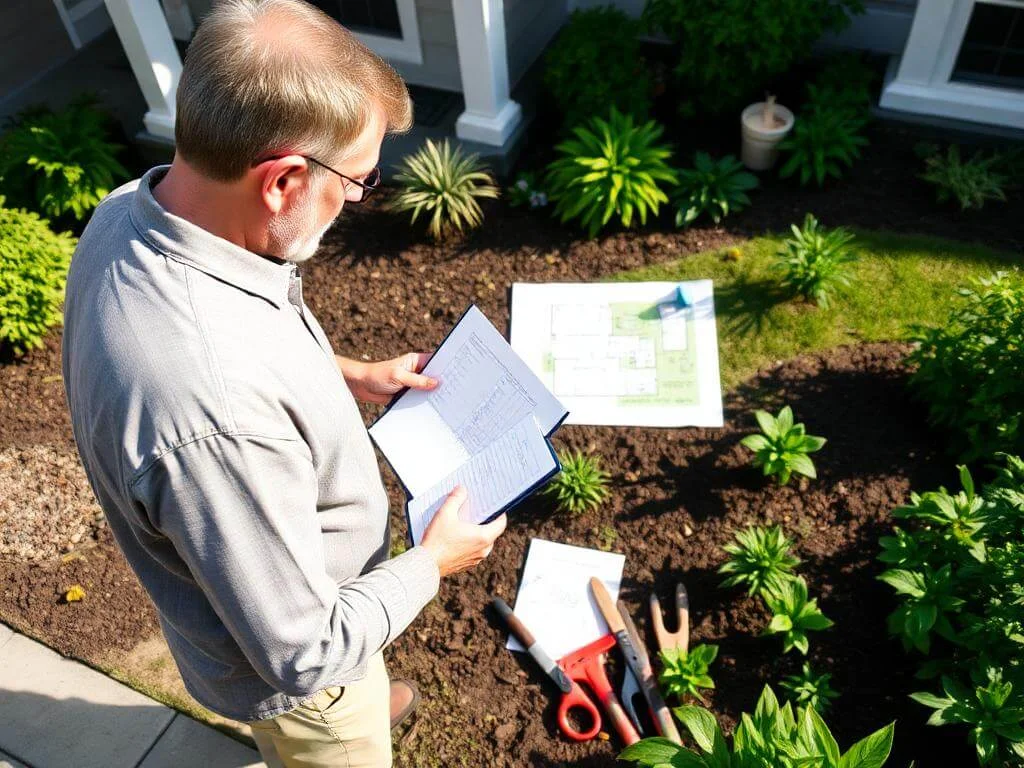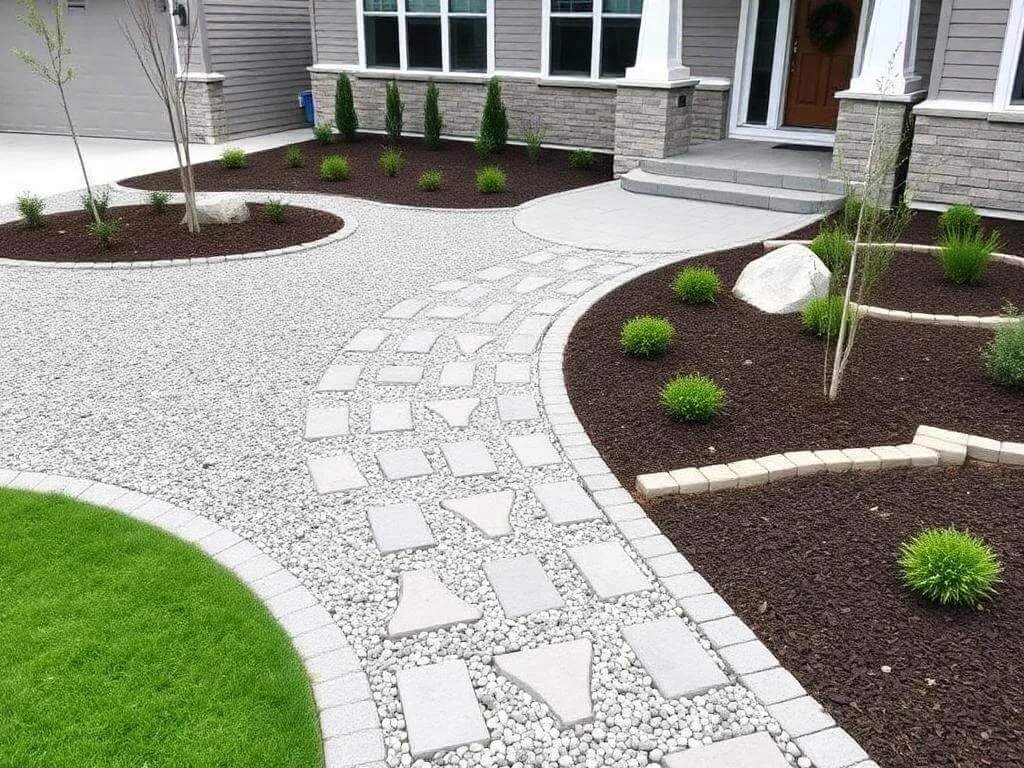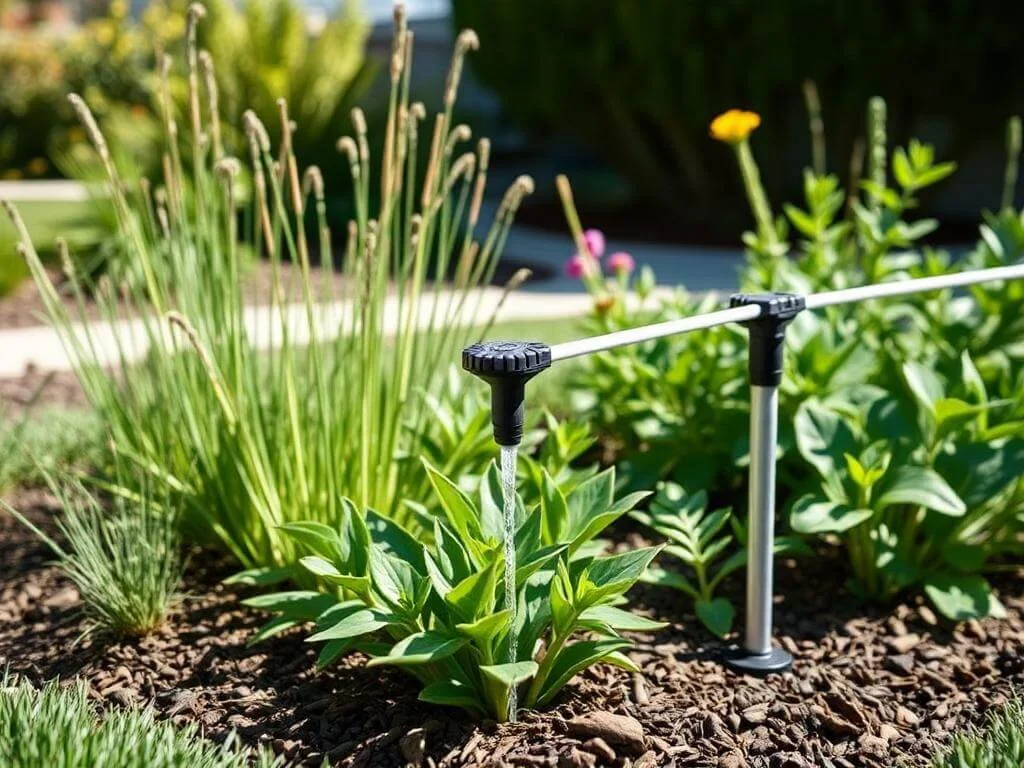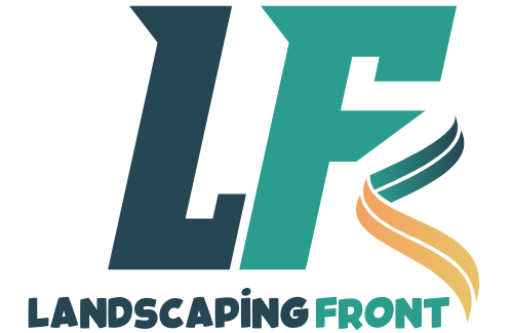Imagine stepping out your front door to a stunning yard that looks gorgeous year-round without demanding hours of upkeep. Low-maintenance front yard landscaping offers the perfect solution for busy homeowners or anyone looking to save time, money, and effort. By combining thoughtful planning, the right plants, and sustainable materials, you can create an outdoor space that conserves water, reduces maintenance tasks, and enhances your home’s curb appeal. This guide will walk you through step-by-step strategies for designing a low-maintenance front yard landscape that’s both practical and beautiful. Let’s get started!

I. Planning Your Low-Maintenance Front Yard Landscape
Proper planning is the foundation of a successful low-maintenance front yard landscape. With a clear vision, you can ensure your yard is both functional and easy to care for, all while maximizing its visual appeal. Here’s how to get started:
A. Assess Your Site
Before diving into design, take time to evaluate the unique characteristics of your yard. A thoughtful assessment helps you make informed decisions that align with your environment.
- Sunlight: Determine whether your yard gets full sun, partial shade, or full shade. This will guide your choice of plants that thrive naturally in your yard’s light conditions.
- Soil Type: Identify whether you have clay, sandy, or loamy soil. You may need to amend the soil to support plant health.
- Existing Features: Consider the placement of trees, walkways, and utilities. Incorporate these elements into your plan rather than working against them.
- Local Climate: Understand your area’s climate, including rainfall patterns and temperature extremes. Low-maintenance landscaping often means using plants and materials that are suited to your region’s weather.
B. Define Your Style and Needs
Your front yard should reflect both your taste and practical requirements.
- Consider Your Home’s Architecture: Choose a landscape style—modern, rustic, cottage, or minimalist—that complements your home’s design.
- Think About Yard Usage: Will you need space for seating, a play area, or pathways? Identify how you intend to use the space to prioritize functionality.
- Browse Inspiration: Use platforms like Pinterest or Houzz to gather ideas. Look for designs specifically suited to low-maintenance front yard landscaping to inspire your vision.
C. Set a Budget
A clear budget ensures you can achieve your landscaping goals without overspending.
- Factor in Plant Costs: Choose drought-tolerant and native plants that require less upkeep and water.
- Materials and Labor: Account for hardscaping materials, such as gravel, mulch, and pavers, along with potential labor costs if you’re hiring professionals.
- Plan for Maintenance: Even low-maintenance yards need occasional care. Include costs for tools, drip irrigation systems, or seasonal supplies.
By thoroughly planning your low-maintenance front yard landscape, you’ll set yourself up for a space that’s beautiful, practical, and perfectly suited to your lifestyle. Keep these considerations in mind as you move on to selecting plants and materials tailored to your needs.

II. Choosing the Right Plants
Selecting the right plants is key to achieving a beautiful, low-maintenance front yard landscape. By focusing on drought-tolerant options, native plants, and strategic groundcovers, you can create a sustainable yard that thrives with minimal care. Here’s how to make the best choices:
A. Drought-Tolerant Plants
Drought-tolerant plants are a cornerstone of low-maintenance landscaping. These plants thrive in dry conditions and require little water once established, making them perfect for busy homeowners and water conservation.
- What Are Drought-Tolerant Plants?: These are plants that can survive with minimal watering, thanks to their ability to store water or adapt to dry climates.
- Examples to Consider:
- Succulents: Aloe, agave, and echeveria add texture and visual interest.
- Ornamental Grasses: Blue fescue and feather reed grass offer movement and structure.
- Herbs: Lavender and rosemary provide beauty and fragrance while thriving in dry soil.
- Pro Tip: Incorporate a mix of heights and textures for a visually appealing design.
B. Native Plants
Native plants are an excellent choice for low-maintenance front yard landscaping because they are naturally adapted to your local climate and soil.
- Why Choose Native Plants?
- Require less water and fertilizer.
- Support local wildlife, including bees, butterflies, and birds.
- Are more resistant to pests and diseases in your region.
- Finding Native Plants: Check with local extension services, native plant societies, or nurseries specializing in indigenous species. Popular examples include coneflowers, black-eyed Susans, and milkweed.
C. Groundcovers
Groundcovers play a critical role in low-maintenance yards by suppressing weeds, conserving soil moisture, and reducing the need for frequent mulching.
- Benefits of Groundcovers:
- Minimize exposed soil where weeds can grow.
- Add color and texture to areas where grass might struggle to thrive.
- Low-Maintenance Options:
- Creeping Thyme: Aromatic and great for sunny spots.
- Sedum: Thrives in dry, rocky areas.
- Ajuga: A shade-loving option with vibrant foliage.
D. Shrubs and Trees
Strategically placed shrubs and trees provide structure, shade, and year-round appeal with little maintenance.
- Low-Maintenance Shrubs:
- Boxwood: Ideal for hedges and requires minimal pruning.
- Junipers: Hardy and drought-tolerant, perfect for groundcover or accents.
- Low-Maintenance Trees:
- Dwarf Conifers: Slow-growing and require little shaping.
- Crape Myrtle: A flowering tree that thrives in hot climates with minimal care.
- Placement Matters: Choose locations carefully to reduce future pruning needs and ensure proper growth.
By focusing on these plant types, you can design a low-maintenance front yard landscape that’s both stunning and sustainable. Remember to group plants with similar water and sunlight needs for even easier care!

III. Hardscaping and Materials
Hardscaping and materials play a pivotal role in creating a durable, functional, and visually appealing low-maintenance front yard landscape. By incorporating well-chosen elements like mulch, gravel, stone, and pavers, you can reduce maintenance efforts while enhancing the overall design of your yard.
A. Mulch
Mulching is a simple yet effective strategy to maintain a low-maintenance front yard. It suppresses weeds, retains soil moisture, and improves the overall appearance of your landscaping.
- Benefits of Mulching:
- Reduces weed growth, minimizing the need for frequent weeding.
- Helps retain soil moisture, especially during dry seasons.
- Regulates soil temperature to protect plant roots.
- Types of Mulch:
- Bark Mulch: Organic and great for plant beds; replenishes soil nutrients as it decomposes.
- Rock Mulch: Durable, long-lasting, and ideal for areas that don’t require frequent replanting.
- Gravel: Offers a clean, modern look and works well for pathways or decorative borders.
- Pro Tip: Apply mulch 2–3 inches thick around plants, ensuring it doesn’t touch the stems or trunks to avoid rot.
B. Gravel and Stone
Gravel and stone are versatile materials that contribute to both aesthetics and functionality in low-maintenance front yard landscaping.
- How to Use Gravel and Stone:
- Pathways: Create defined walkways to prevent foot traffic from compacting soil or damaging plants.
- Borders: Use decorative stones to edge flower beds or separate different zones in your yard.
- Ground Cover: Replace large areas of grass with gravel or crushed stone for a polished, no-mow solution.
- Low-Maintenance Benefits: These materials require no watering, mowing, or fertilizing, making them ideal for dry climates and busy homeowners.
- Design Tip: Choose natural colors that complement your home’s exterior and landscaping style.
C. Pavers and Concrete
Pavers and concrete surfaces provide long-lasting, low-maintenance options for walkways, patios, and driveways.
- Why Choose Pavers or Concrete?
- Pavers: Interlocking pavers are durable, easy to install, and available in a wide range of colors, shapes, and textures.
- Stamped Concrete: A cost-effective alternative that mimics the look of natural stone or brick.
- Permeable Pavers: Allow water to drain through, helping with stormwater management and reducing runoff.
- Applications:
- Walkways that guide visitors through your yard.
- Patios for seating areas or decorative focal points.
- Driveways that require minimal maintenance and remain visually appealing.
- Maintenance Tips:
- Sweep regularly to remove debris.
- Power wash as needed to maintain cleanliness and appearance.
By integrating these hardscaping materials into your low-maintenance front yard landscape, you can reduce upkeep while enhancing functionality and curb appeal. The combination of mulch, gravel, stone, and pavers saves time and creates a polished and professional-looking outdoor space.

IV. Irrigation and Water Management
Efficient irrigation and water management are essential components of any low-maintenance front yard landscape. By choosing water-saving methods and designing your yard with proper drainage in mind, you can conserve resources while ensuring healthy plants and a thriving outdoor space.
A. Drip Irrigation
Drip irrigation is a low-maintenance, water-efficient solution that delivers water directly to the roots of your plants, minimizing waste and promoting healthy growth.
- Benefits of Drip Irrigation:
- Reduces water waste caused by evaporation and runoff.
- Ensures consistent watering, which is especially important for drought-tolerant and native plants.
- Requires minimal maintenance once installed.
- Installation Tips:
- Lay drip lines around the base of plants to target their root zones.
- Use a timer to automate watering, further reducing manual effort.
- Regularly check for clogs or leaks to ensure the system functions efficiently.
- Pro Tip: Pair drip irrigation with mulch to maximize water retention and reduce evaporation.
B. Rain Gardens (Optional for Rain-Prone Areas)
Rain gardens are a sustainable and visually appealing way to manage stormwater runoff while enhancing your low-maintenance landscape.
- What Is a Rain Garden?
- A shallow, planted depression designed to collect and absorb rainwater runoff from roofs, driveways, and other surfaces.
- Benefits of Rain Gardens:
- Reduce water pooling and erosion in your yard.
- Filter pollutants before water reenters the ground or stormwater systems.
- Provide habitat for pollinators and other beneficial wildlife.
- Design Tips:
- Use a mix of deep-rooted native plants and drought-tolerant species for optimal performance.
- Place the rain garden in a low spot in your yard, at least 10 feet away from your home’s foundation.
C. Proper Watering Techniques
Even in a low-maintenance front yard landscape, occasional watering is necessary, especially during dry periods or for newly planted vegetation. Proper techniques can make a big difference.
- Deep, Infrequent Watering:
- Water deeply to encourage plants to develop strong, deep roots.
- Avoid frequent shallow watering, which can lead to weak root systems and higher water demand.
- Early Morning Watering:
- Water in the early morning to reduce evaporation and give plants time to absorb moisture before the heat of the day.
- Adjust for Seasons:
- Reduce watering during cooler months or when rainfall is sufficient.
- Increase frequency during hot, dry periods to support plant health.
Efficient irrigation and water management not only support a low-maintenance front yard landscape but also contribute to sustainability by conserving water and reducing unnecessary runoff. With methods like drip irrigation, rain gardens, and proper watering techniques, you can maintain a beautiful yard with minimal effort.

V. Maintaining Your Low-Maintenance Landscape
Even the best-designed low-maintenance front yard landscape requires occasional care to keep it looking its best. By focusing on simple, routine tasks like weeding, pruning, and seasonal cleanup, you can preserve your yard’s beauty and functionality with minimal effort.
A. Weeding
While a low-maintenance landscape minimizes weed growth, some maintenance is still necessary to keep your yard tidy and weed-free.
- Strategies for Minimizing Weeds:
- Mulch: Apply a 2–3 inch layer of organic or rock mulch to suppress weed growth and conserve soil moisture.
- Groundcovers: Plant low-maintenance groundcovers like creeping thyme or sedum to crowd out weeds naturally.
- Pre-Emergent Herbicides: Use pre-emergent herbicides in early spring to prevent weed seeds from germinating.
- Weeding Tips:
- Remove weeds by hand or with a weeding tool as soon as they appear to prevent them from spreading.
- Weed after rainfall or watering when the soil is soft for easier removal.
B. Pruning
Pruning keeps shrubs, trees, and perennials healthy and well-shaped, reducing the risk of overgrowth and disease.
- Basic Pruning Techniques:
- Prune shrubs and trees in late winter or early spring before new growth begins.
- Remove dead, damaged, or diseased branches to maintain plant health.
- Trim plants to control their size and shape, focusing on low-maintenance varieties that don’t require frequent pruning.
- Pro Tip: Use sharp, clean pruning tools to make precise cuts and reduce the risk of spreading disease.
C. Seasonal Cleanup
Seasonal cleanup ensures your low-maintenance front yard landscape remains neat and ready for the next growing season.
- Spring Tasks:
- Remove debris like leaves and fallen branches.
- Replenish mulch and inspect irrigation systems for damage.
- Divide and replant perennials if needed.
- Summer Tasks:
- Check for weeds and water plants as necessary, especially during dry spells.
- Keep pathways and hardscapes clear of dirt and debris.
- Fall Tasks:
- Rake up fallen leaves to prevent them from smothering groundcovers or harboring pests.
- Cut back perennials to prepare them for dormancy.
- Clean and store garden tools for winter.
- Winter Tasks:
- Remove snow from pathways if applicable.
- Inspect trees and shrubs for damage caused by ice or snow.
By incorporating these simple maintenance routines, you can keep your low-maintenance front yard landscape looking pristine with minimal time and effort. Regular upkeep not only preserves your yard’s appearance but also ensures the health and longevity of your plants and hardscape elements.

VI. Low Maintenance Front Yard Landscaping Ideas for Specific Situations
Every front yard is unique, and tailoring your low-maintenance front yard landscape to your specific circumstances can help you achieve the best results. Whether you’re working with limited space, a sloped yard, or challenging climates, these ideas will help you create a functional and beautiful outdoor space with minimal upkeep.
A. Small Front Yards
Designing for a small front yard requires maximizing space while keeping maintenance low.
- Use Vertical Space:
- Install trellises or vertical gardens to add greenery without taking up valuable ground space.
- Choose climbing plants like clematis or star jasmine for vertical appeal.
- Focus on Key Features:
- Create a focal point, such as a small fountain or a potted arrangement of drought-tolerant plants.
- Use bold, contrasting colors to make the space feel larger and more dynamic.
- Low-Maintenance Plants: Stick to compact varieties like dwarf shrubs, succulents, and groundcovers that thrive in small spaces.
B. Sloped Front Yards
Sloped yards can be challenging to maintain, but strategic design can turn them into stunning, low-maintenance landscapes.
- Terracing:
- Create terraced levels using stone or wood retaining walls to prevent erosion and make planting easier.
- Plant drought-tolerant groundcovers like creeping juniper or ice plant on slopes to stabilize the soil and reduce mowing needs.
- Pathways and Steps:
- Use gravel or stone pathways to navigate slopes safely while adding visual interest.
- Water Flow Management:
- Incorporate a dry creek bed to channel rainwater and enhance the yard’s aesthetic appeal.
C. Dry Climates/Xeriscaping
For homeowners in arid regions, xeriscaping is an excellent option for creating a water-efficient, low-maintenance front yard.
- Focus on Drought-Tolerant Plants:
- Use succulents, cacti, and other plants like lavender or yucca that require minimal watering.
- Gravel and Stone Landscaping:
- Replace traditional grass with gravel, decomposed granite, or decorative stones for a modern, no-mow look.
- Group Plants by Water Needs:
- Place plants with similar water requirements together to simplify irrigation and conserve water.
- Add Shade Elements:
- Plant native trees or install pergolas to provide shade and reduce the need for frequent watering.
D. Front Yards with Full Shade
If your yard doesn’t get much sunlight, you can still create a vibrant low-maintenance landscape with shade-loving plants and thoughtful design.
- Shade-Tolerant Plants:
- Use hostas, ferns, and heucheras for lush greenery.
- Incorporate flowering plants like astilbe or impatiens for pops of color.
- Hardscape Features:
- Add seating areas, pathways, or decorative boulders to make the most of shaded spaces.
- Groundcovers for Shade:
- Opt for low-maintenance groundcovers like pachysandra or sweet woodruff to cover bare soil and suppress weeds.
By considering these specific situations and tailoring your approach, you can create a low-maintenance front yard landscape that thrives in any condition. These ideas ensure your yard is not only practical and sustainable but also visually appealing, regardless of its size, slope, or climate.

Conclusion
Creating a low-maintenance front yard landscape is an achievable goal that combines practicality with beauty. By following a thoughtful approach—starting with proper planning, selecting the right plants, incorporating smart hardscaping elements, and optimizing irrigation—you can enjoy a stunning front yard that requires minimal upkeep.
Low-maintenance landscaping offers numerous benefits, including time savings, reduced water consumption, and long-term cost-effectiveness. Whether you’re working with a small yard, a sloped landscape, or challenging climates, there’s a solution tailored to your specific needs.
Remember, a successful low-maintenance yard isn’t about eliminating care altogether but rather designing a space that thrives with minimal intervention. Start today by assessing your yard, exploring drought-tolerant and native plants, and incorporating sustainable practices like mulch and drip irrigation.
